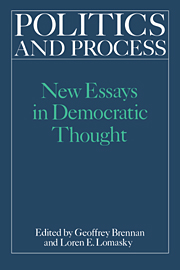Book contents
- Frontmatter
- Contents
- Acknowledgments
- List of contributors
- Introduction
- Chapter 1 The justification of democracy
- Chapter 2 Large numbers, small costs: the uneasy foundations of democratic rule
- Chapter 3 Evaluating the institutions of liberal democracy
- Chapter 4 Democracy: the public choice approach
- Chapter 5 The democratic order and public choice
- Chapter 6 Radical federalism: responsiveness, conflict, and efficiency
- Chapter 7 Contractarian presuppositions and democratic governance
- Chapter 8 In quest of the social contract
- Chapter 9 Rationality and the justification of democracy
- Chapter 10 The morality of democracy and the rule of law
- Index
Chapter 6 - Radical federalism: responsiveness, conflict, and efficiency
Published online by Cambridge University Press: 29 September 2009
- Frontmatter
- Contents
- Acknowledgments
- List of contributors
- Introduction
- Chapter 1 The justification of democracy
- Chapter 2 Large numbers, small costs: the uneasy foundations of democratic rule
- Chapter 3 Evaluating the institutions of liberal democracy
- Chapter 4 Democracy: the public choice approach
- Chapter 5 The democratic order and public choice
- Chapter 6 Radical federalism: responsiveness, conflict, and efficiency
- Chapter 7 Contractarian presuppositions and democratic governance
- Chapter 8 In quest of the social contract
- Chapter 9 Rationality and the justification of democracy
- Chapter 10 The morality of democracy and the rule of law
- Index
Summary
This essay argues that local government is far more responsive than government at the national level. It further argues that exit, or voting with one's feet, is generally a more effective method of ensuring governmental responsiveness than voice, or voting with the ballot. Thus, the conclusion is that local government would be more responsive than national government. However, local government with freedom of exit but no democracy would be more responsive than local government with democracy but no exit. The ideal combination would be local government combined with both exit and democracy, for each would enhance the effectiveness of the other.
Introduction: three examples
Appalled by conditions in the English factory system of the early nineteenth century, Parliament enacted various “factory acts” that were intended to limit the number of hours children could work and to force children entirely out of certain occupations deemed too dangerous. The result of this “enforced leisure” of children was a reduction in their earnings and in some cases a loss of employment. This imposed severe economic hardship on children as well as their families. There were numerous reports of children attempting to avoid these laws by drifting to smaller factories and workshops that were able to evade the provisions of the acts.
- Type
- Chapter
- Information
- Politics and ProcessNew Essays in Democratic Thought, pp. 149 - 173Publisher: Cambridge University PressPrint publication year: 1989
- 3
- Cited by

